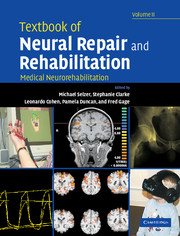Book contents
- Frontmatter
- Contents
- Preface
- Contributors
- Contributors
- Neural repair and rehabilitation: an introduction
- Section A Technology of neurorehabilitation
- Section A1 Outcomes measurement and diagnostic technology
- Section A2 Therapeutic technology
- Section B Symptom-specific neurorehabilitation
- Section B1 Sensory and motor dysfunctions
- Section B2 Vegetative and autonomic dysfunctions
- Section B3 Cognitive neurorehabilitation
- Section C Disease-specific neurorehabilitation systems
- 32 The organization of neurorehabilitation services: the rehabilitation team and the economics of neurorehabilitation
- 33 Traumatic brain injury
- 34 Neurorehabilitation in epilepsy
- 35 Parkinson's disease and other movement disorders
- 36 Neurorehabilitation of the stroke survivor
- 37 Rehabilitation in spinal cord injury
- 38 Multiple sclerosis
- 39 Cerebral palsy and paediatric neurorehabilitation
- 40 Neuromuscular rehabilitation: diseases of the motor neuron, peripheral nerve and neuromuscular junction
- 41 Muscular dystrophy and other myopathies
- Index
- Plate section
39 - Cerebral palsy and paediatric neurorehabilitation
from Section C - Disease-specific neurorehabilitation systems
Published online by Cambridge University Press: 04 August 2010
- Frontmatter
- Contents
- Preface
- Contributors
- Contributors
- Neural repair and rehabilitation: an introduction
- Section A Technology of neurorehabilitation
- Section A1 Outcomes measurement and diagnostic technology
- Section A2 Therapeutic technology
- Section B Symptom-specific neurorehabilitation
- Section B1 Sensory and motor dysfunctions
- Section B2 Vegetative and autonomic dysfunctions
- Section B3 Cognitive neurorehabilitation
- Section C Disease-specific neurorehabilitation systems
- 32 The organization of neurorehabilitation services: the rehabilitation team and the economics of neurorehabilitation
- 33 Traumatic brain injury
- 34 Neurorehabilitation in epilepsy
- 35 Parkinson's disease and other movement disorders
- 36 Neurorehabilitation of the stroke survivor
- 37 Rehabilitation in spinal cord injury
- 38 Multiple sclerosis
- 39 Cerebral palsy and paediatric neurorehabilitation
- 40 Neuromuscular rehabilitation: diseases of the motor neuron, peripheral nerve and neuromuscular junction
- 41 Muscular dystrophy and other myopathies
- Index
- Plate section
Summary
Cerebral palsy (CP) is the most common physical or motor disability affecting children in developed countries, the prevalence being 2.0–2.5 per 1000 live births (Stanley et al., 2000). The prevalence has largely remained constant for decades, with improvements in peri-natal care meaning that more children were saved (including those with disability) and the incidence of very pre-term babies were increased in the 1990s (Stanley et al., 2000). Despite being a common and important clinical problem, there is still lack of precision in the definition of CP (Flett, 2003) or as some prefer “the cerebral palsies” (Miller and Clark, 1998). While the definitions of CP have been refined from time to time, there appears to be general agreement that the condition is characterised by “aberrant control of movement or posture appearing in early life, secondary to central nervous system lesion, damage or dysfunction and not the result of a recognised progressive or degenerative brain disease” (Nelson and Ellenberg, 1978).
There would appear to be at least four features to this heterogenous group of conditions. Firstly, a simple cause–effect relationship is unlikely in most cases. Careful epidemiological and brain-imaging studies suggest that CP frequently has antenatal antecedents, multiple factors and is rarely due to the events of labour and delivery alone. Increasingly, cerebral malformations such as syndromes featuring a neuronal migrational disorder and mitochondrial disorders with or without known chromosomal linkages are being identified.
Keywords
- Type
- Chapter
- Information
- Textbook of Neural Repair and Rehabilitation , pp. 636 - 656Publisher: Cambridge University PressPrint publication year: 2006
- 1
- Cited by

